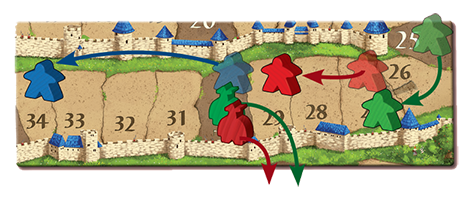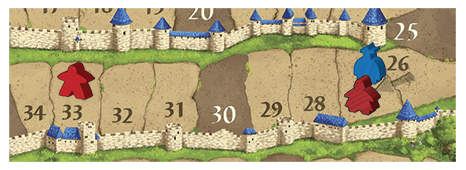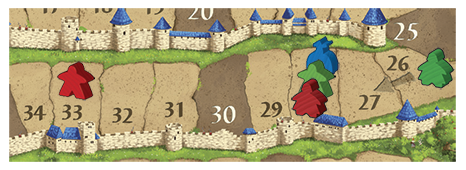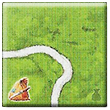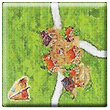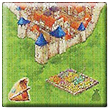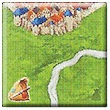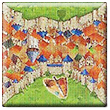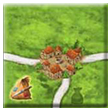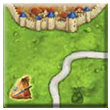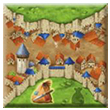The Robbers
 |
You are reading the rules for this tile design. |  |
 | Read the following rules if your tiles look like this. |
| If your tiles have a different design, then choose a game from Spin-offs. |  |
Robbers on the road demand tribute from wayward travelers. When your meeples score points, another player's robber may steal some.
General info and comments
The Robbers (Mini #6) was released by HiG for the second edition, known as C2 for short, in 2017, bundled as part of Big Box 6. A third edition, known as C3 for short, was released in 2021 including more detailed graphics, cities with clipped buildings and some minor wording changes. The C3 version of this expansion is only available as part of Big Box 7.
This expansion was originally released for the first edition, known as C1 for short, in 2012.
Contents
- 8 landscape tiles with a robber logo (bag)
- 6 robber figures
Rules
Preparation
Shuffle the new landscape tiles with those of the basic game and stack them normally. Each player adds the robber of their color to their supply.
Gameplay
1. Placing a tile
Whenever you draw a tile with a bag, place it normally. Then, you may place your robber on the scoreboard, choosing a space that is occupied by at least one other player's scoring figure. [1] [2] Then, the next player to the left with no robber on the scoreboard is allowed to place it. [3] If your robber is already on the scoreboard, you may choose to move it to a different space.
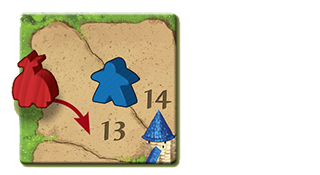
![]() Question: If the tile with a bag completes a feature from an opponent, may a player placing (or moving) their robber place it on the same space as the opponent's scoring meeple and score rogue points for it?
Question: If the tile with a bag completes a feature from an opponent, may a player placing (or moving) their robber place it on the same space as the opponent's scoring meeple and score rogue points for it?
Answer: Yes, there is no limitation in the rules to do this.
2. Placing a meeple
When you place a tile with a bag, you may place a meeple on it according to the usual rules.
Note: The figures in this expansion are not placed on the standard land tiles as part of the game.
3. Scoring a feature
Stealing points
If your robber is on the same space as another player's scoring meeple when it moves (from scoring points), the robber "steals" points. You score half the points that the other player scored (rounded up), [5] [6] which you track by moving your own scoring meeple accordingly along the scoreboard. The owner of the "robbed" meeple still gets all of their points. Then, return your robber to your supply.
Additional rules
- If your robber is on the same space as a scoring meeple that moves as a result of points gained from robbing another player (rogue points), you do not score any points. Instead, your robber is placed on the same space as the scoring meeple that moved to be later robbed. ("Robbers don't rob other robbers.")
- If given the opportunity, your robber must steal points. You cannot wait for a later feature that might be worth more points. [7]
- If your robber is on the same space as more than one meeple, and more than one of them is scoring points the same turn, you may choose which one to steal from. [8] [9] [10] [11]
- If there are multiple robbers on the same space as a meeple that scores points, each robber on that space steals from that meeple.
- Your robber cannot steal from you.
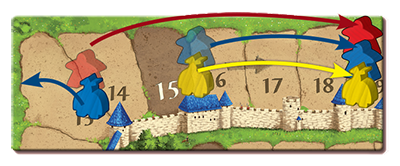
Final Scoring
After the game ends but before final scoring, if your robber is still on the scoreboard, you score 3 points, then return your robber to your supply.
Interactions with other expansions
If playing with other expansions, please take the following notes into consideration:
![]() If either your messenger or your scoring meeple lands on a dark space as a result of your robber stealing points from another player, draw a message tile.
If either your messenger or your scoring meeple lands on a dark space as a result of your robber stealing points from another player, draw a message tile.
Detailed examples using the robber and the messages
Example #1
The blue robber is on the same space as your messenger. Your scoring meeple is on a different space. With placement of one tile, you score points for both a road (3 points) and a city (6 points.)
Each feature is scored separately. You decide which of your scoring figures moves on the scoring board. The blue player only receives "robber points" for the first movement of the scoring figure that stands on the same space as the blue robber – here your messenger.
One of the following 4 options can happen :
- First, your messenger scores 3 points for the road. After that, your scoring meeple scores 6 points for the city. Then the blue robber robs half of the points from the your messenger (2 Points.)
- First, your scoring meeple scores 3 points for the road. After that, your messenger scores 6 points for the city. Then the blue robber robs half of the points from the your messenger (3 Points.)
- First, your messenger scores 3 points for the road. After that, your messenger scores 6 points for the city. Then the blue robber robs half of the points for the road (the first score) from the your messenger (2 Points.) [12]
- First, your scoring meeple scores 3 points for the road. After that, your scoring meeple scores 6 points for the city. Here, the blue robber robs nothing from you because your scoring meeple was not on the same space as the blue robber.
Example #2
The blue robber is on the same space as the green scoring meeple and your messenger. The other scoring figures for the green player and you are standing on different spaces. With placement of one tile, the green player scores points for a road (3 points) and you score points for a city (6 points.)
The blue robber is on a space occupied by more than one scoring figure, and both of the scoring figures (more than one) are scoring points. Thus, the blue robber chooses which player he will "rob" half of the points from. The green player and you can choose which of their scoring figures move when points are scored. The blue robber can only receive points from a scoring figure that stands on the same space.
One of the following 3 options can happen :
- The green player and you both decide to score with your scoring figures that are standing on the same space as the blue robber. The blue robber decides to rob the half of the points from your messenger (3 Points.)
- The green player decides to score with the green scoring meeple and you also decide to score with your scoring meeple. The blue robber can only rob the half of the points from the green scoring meeple (2 Points) since your scoring meeple is not on the same space as the blue robber.
- The green player and you both decide to score with your scoring figures that are standing on different spaces from the blue robber. The blue robber can't rob any points from the green messenger or your scoring meeple, as the blue robber isn’t on the same space as either one of them.
Example #3
The blue robber is on the same space as the green scoring meeple, the green messenger, and your scoring meeple. Your messenger stands on a different space. With placement of one tile, the green player scores points for a road (3 points) and for a city (6 points), and you score points for a road (2 points) and for a city (8 points.)

- The blue robber, the green scoring meeple, the green messenger, and your scoring meeple share the same space.
- Your messenger is on a different space.
- The green player scores points for a road (3 points) and for a city (6 points), and you score points for a road (2 points) and for a city (8 points.)
Each feature scores separately. The green player and you can choose which of your scoring figures will score the points. The blue robber can only receive points from a scoring figure that stands on the same space as the blue robber. In this case, the blue robber can definitely receive points from the green player, because both scoring figures from the green player are on the same space. The blue robber’s ability to rob points from you will depend on which figure(s) you choose to move. Since the blue robber is on a space occupied by more than one scoring figure, and more than one figure is scoring points, the blue robber chooses which player he is "robbing" half the points from. The blue robber gets all of the information that he/she needs about movement from the other players (you and the green player) before making the best decision about which points to rob.
One of the following 3 options can happen:
- The green player and you each score with one of the scoring figures that was standing on the same space as the blue robber. They both decide to score their roads first. The green player first scored the road worth 3 points with the green messenger. You then scored the road worth 2 points with your scoring meeple. The blue robber decided to rob half of the points from the green messenger (2 points), because robbing from your scoring meeple would have only been worth 1 point.
Since both the green player and you chose to score your cities second with the same figures, the blue robber could not get half of the points from either city. The blue robber could only choose to rob the first green points or your first points available. If, however, the green player had scored the city with the green scoring meeple, the blue robber could have robbed half of those points, since that would have been yet another scoring figure to choose to rob from. - You decide to first score the road worth 2 points with your messenger, which does not stand on the same space as the blue robber. The green player first scores the road worth 3 points with the green messenger. You then use your scoring meeple to score the city worth 8 points. The blue robber decides to rob half of the points from your scoring meeple (4 points), because there were only 2 points available from the green messenger.
- You decide to first score the road worth 2 points with your messenger, which does not stand on the same space as the blue robber. Then you also score the city worth 8 points with your messenger. The green player first scores the city worth 6 points with the green scoring meeple. The blue robber can only rob half the points from the green scoring meeple (3 points) because your messenger is not standing on the same space as the blue robber.
Example #4
The blue robber and the yellow robber are on the same space as the green scoring meeple, the green messenger, and your scoring meeple. Your messenger stands on a different space. With the placement of one tile, the green player scores points for a road (3 points) and for a city (6 points), and you score points for a road (2 points) and for a city (8 points.)
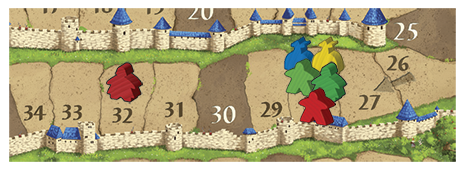
- The blue robber, the yellow robber, the green scoring meeple, the green messenger, and your scoring meeple share the same space.
- Your messenger is on a different space.
- The green player scores points for a road (3 points) and for a city (6 points), and you score points for a road (2 points) and for a city (8 points.)
Each feature scores separately. The green player and you can choose which of your scoring figures will score the points. The blue robber and yellow robber can only receive points from a scoring figure that stands on the same space that each of them is on. In this case, the blue robber and the yellow robber can definitely receive points from the green player, because both scoring figures from the green player are on the same space. The robbers’ ability to rob points from you will depend on which figure(s) you choose to move. Since the blue robber and the yellow robber are on a space occupied by more than one scoring figure, and more than one figure is scoring points, each robber chooses which player he is "robbing" half the points from. The blue robber and the yellow robber get all of the information that they need about movement from the other players (you and the green player) before making the best decision about which points to rob.
One of the following 3 options can happen:
- The green player and you each score with one of the scoring figures that was standing on the same space as the blue robber and the yellow robber. They both decide to score their roads first.
The green player first scored the road worth 3 points with the green messenger. You then scored the road worth 2 points with your scoring meeple. The blue robber decided to rob half of the points from the green messenger (2 points), and the yellow robber decided to rob from your scoring meeple (1 point.) Why choose to take fewer points? If yellow is the active player and can receive a message, this makes more sense. - You decide to first score the road worth 2 points with your messenger, which does not stand on the same space as the robbers. The green player first scores the road worth 3 points with the green messenger. You then use your scoring meeple to score the city worth 8 points. The blue robber and the yellow robber each decide to rob half of the points from your scoring meeple (4 points), because there were only 2 points available from the green messenger.
- You decide to first score the road worth 2 points with your messenger, which does not stand on the same space as the robbers. Then you also score the city worth 8 points with your messenger. The green player first scores the city worth 6 points with the green scoring meeple. The blue robber and the yellow robber can only rob half the points from the green scoring meeple (3 points) because your messenger is not standing on the same space as the robbers.
Tile distribution
C3 Edition
C2 Edition
Footnotes
For Icons explanation and licensing please visit Icons page.
- ↑
 If playing with The Messengers expansion, the robber can be placed beside either a scoring meeple or the messenger. Thus, the robber can get points from either scoring figure, but only from the one on the same space as the robber. (5/2013)
If playing with The Messengers expansion, the robber can be placed beside either a scoring meeple or the messenger. Thus, the robber can get points from either scoring figure, but only from the one on the same space as the robber. (5/2013)
- ↑
 In C2, the ZMG rules modified this sentence to state that the robber placement was mandatory. This discrepancy may be due to a mistranslation.
In C2, the ZMG rules modified this sentence to state that the robber placement was mandatory. This discrepancy may be due to a mistranslation.
This discrepancy was eliminated in C3. - ↑
 In C2, the ZMG rules modified this sentence to state that "in turn order, each player places their robber on the scoreboard, also choosing spaces occupied by other player's meeples." This discrepancy may be due to a mistranslation.
In C2, the ZMG rules modified this sentence to state that "in turn order, each player places their robber on the scoreboard, also choosing spaces occupied by other player's meeples." This discrepancy may be due to a mistranslation.
This discrepancy was eliminated in C3. - ↑
 The caption of this example was altered by ZMG to match the modified robber placement rule:
The caption of this example was altered by ZMG to match the modified robber placement rule:
Example 1: Turn order is you, the blue player, the yellow player, then the green player. You draw and place a tile with a bag, and place your robber on the scoreboard, on the same space as the blue meeple. The blue, yellow, and then green players may then place their robbers on the scoreboard, in order. - ↑
 The robber can receive points from The Wheel of Fortune or fairy scoring. (5/2013)
The robber can receive points from The Wheel of Fortune or fairy scoring. (5/2013)
- ↑
 If the robber is on a space with a scoring meeple that moves backwards (such as from a bazaar payment or tower ransom), the robber moves backwards with the scoring meeple, but the player who owns the robber does not lose points. (3/2015)
If the robber is on a space with a scoring meeple that moves backwards (such as from a bazaar payment or tower ransom), the robber moves backwards with the scoring meeple, but the player who owns the robber does not lose points. (3/2015)
- ↑
 Each scoring event is separate from all others – each feature is scored individually. The robber must take points only from the first allowable event – single feature points, fairy point, catapult points, Wheel of Fortune points, etc. (5/2013)
Each scoring event is separate from all others – each feature is scored individually. The robber must take points only from the first allowable event – single feature points, fairy point, catapult points, Wheel of Fortune points, etc. (5/2013)
- ↑
 If a single scoring figure moves multiple times due to scoring of more than one feature with placement of a single tile, the player receiving the points chooses the order that points are awarded. If there is a robber beside that figure, the owner of the robber would thus receive half the points of only the first feature that is scored. Of course, if multiple figures on the same space receive points, the robber’s owner can still choose which figure to steal points from. (5/2013, 11/2014)
If a single scoring figure moves multiple times due to scoring of more than one feature with placement of a single tile, the player receiving the points chooses the order that points are awarded. If there is a robber beside that figure, the owner of the robber would thus receive half the points of only the first feature that is scored. Of course, if multiple figures on the same space receive points, the robber’s owner can still choose which figure to steal points from. (5/2013, 11/2014)
- ↑
 Although this rule refers to multiple figures scoring in "the same turn," the robber cannot necessarily wait until the end of the entire turn to see if it applies. Rather, the robber can only consider those scoring events that would be happening simultaneously. For example, the fairy scoring is separate from scoring of normal features. Thus, if the robber could score due to the fairy point he must take that score; he cannot wait for other events later in the turn. (10/2014; updated 1/2021)
Although this rule refers to multiple figures scoring in "the same turn," the robber cannot necessarily wait until the end of the entire turn to see if it applies. Rather, the robber can only consider those scoring events that would be happening simultaneously. For example, the fairy scoring is separate from scoring of normal features. Thus, if the robber could score due to the fairy point he must take that score; he cannot wait for other events later in the turn. (10/2014; updated 1/2021)
- ↑
 If a robber is on the same space as scoring figures from 2 other players, and one of those figures scores points from robbing another player (rogue points) while the other player does not score anything, the robber must move with the figure rather than staying behind. (Bullet point 1 applies here, but bullet point 3 does not, as only 1 scoring figure is getting points.) (5/2014)
If a robber is on the same space as scoring figures from 2 other players, and one of those figures scores points from robbing another player (rogue points) while the other player does not score anything, the robber must move with the figure rather than staying behind. (Bullet point 1 applies here, but bullet point 3 does not, as only 1 scoring figure is getting points.) (5/2014)
- ↑
 If the robber is on a space with multiple scoring figures, and one of them moves backwards (such as from a bazaar payment or tower ransom), the player who owns the robber can choose to either move the robber backwards with that scoring meeple or keep the robber in the same place with the other scoring meeple(s). (3/2015)
If the robber is on a space with multiple scoring figures, and one of them moves backwards (such as from a bazaar payment or tower ransom), the player who owns the robber can choose to either move the robber backwards with that scoring meeple or keep the robber in the same place with the other scoring meeple(s). (3/2015)
- ↑
 You could have chosen to score the city first, in which case the blue robber would score 3 points. However, it is unlikely that doing that would be in your best interest.
You could have chosen to score the city first, in which case the blue robber would score 3 points. However, it is unlikely that doing that would be in your best interest.





